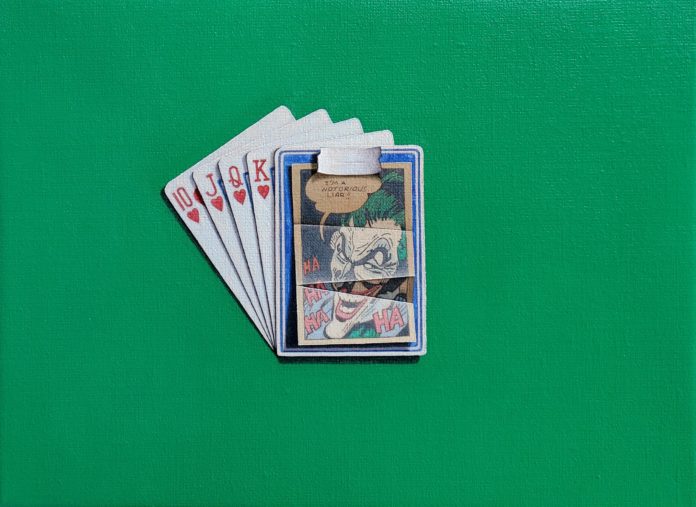“Trompe l’oeil painting was a precursor of modern aesthetics,” says Anthony Mastromatteo. Keep reading his essay on this realism sub-genre here. Anthony Mastromatteo has been on the faculty of the Figurative Art Convention & Expo (which is moving to Realism Live for 2022).
BY ANTHONY MASTROMATTEO
In the early pages of Gertrude Grace Sill’s book, John Haberle: American Master of Illusion, the author relates the following anecdote to give both a history of the relationship of American art history to the term “trompe l’oeil” and to shed light on a central signifying element to the technical practice:
“The term appeared in ‘elite’ publications such as the New York Times and Century Magazine but not in local newspapers and was not used by collectors or ‘imitative’ painters. Haberle himself referred to his painting style as ‘artistic mechanics.’ (The only instance in which trompe l’oeil is used in reference to a Haberle painting is a detail the artist inserted in “imitation’ as a joke: the ‘printed’ newspaper clipping includes the misspelled term ‘trompe l’oeil.'”
It would seem that Haberle’s self-reference to his work as “artistic mechanics” is an obvious acknowledgement of the technical rigor necessary to achieve the effect of the painting. The effect of the painting, however, is anything but rigorous. The effect of the painting is the joke…the mistaken spelling, the implications resulting from the mistaken spelling, the foolishness of the joke and the fooling of the eye. The rigor of technical execution serves the chaos of the jocularity.
I have always felt and have decided to mount the argument that trompe l’oeil painting was a precursor of modern aesthetics and, as a result, is the most interesting of the sub-genres in contemporary realism. The fifth chapter of William T. Noon’s examination of James Joyce’s ouvre, a chapter titled “Acomedy of Letters,” examines the centrality of the comic impulse in the development of Joyce’s work over the span of his writing life. The chapter opens with Noon’s reference to the following anecdote:
“Eugene Jolas relates that at a dinner which he and Madame Jolas gave on the occasion of Joyce’s fiftieth birthday, ‘Someone…gave voice to his dislike for the adage: in vino veritas, which he held to be untrue and bromidic. Joyce agreed warmly and added: ‘It should really be: in riso veritas; for nothing so reveals us as our laughter.’ Jolas adds, ‘He was always astonished that so few people had commented on the comic spirit in his writings.'”
Noon then proceeds to open the reader’s gaze upon the means and implications of Joyce’s growing and central comedic spirit over the course of his body of work. A few years after Noon’s 1957 book, Umberto Eco undertakes the topic in his brilliant 1962 book titled, The Aesthetics of Chaosmos: The Middle Ages of James Joyce. In a sub-section of a chapter on “Finnegan’s Wake” headed “The Poetics of the Pun” Eco sets himself the task of explaining how a pun works as a signifying tool in the mind of the one engaging it.
“Obviously, the reader cannot pursue all of the references in the course of a single reading. One is compelled to choose among possible interpretive paths and to disambiguate various levels of sense…. But even while moving at a given level, one must be alert to the existence of the others which appear in the background, disturbing the linearity of the first and stimulating the reader to feel an ‘uneasiness’ and to suspect a ‘felicity,’ a baroque ‘wit.’ In other words one is compelled to find an order and, at the same time, to realize that there are many possible orders; a given choice does not eliminate the alternatives.”
And so, we have finally arrived at the point of my essay. Inherent in the pun or the joke is a new sense of order…one that is not classical or linear…one that necessitates the holding of many possibilities in one’s experience at the same time even should those possibilities negate all the others. The aesthetic implication of the pun is a negation of classical order and causality. The centrality of the pun or the joke at all levels of trompe l’oeil painting suggests a non-classical sensibility in 19th century trompe l’oeil painting…a sensibility that acted as a harbinger to the assault on classical sensibility embedded in modernism and the movements thereafter. And, thus, my assertion that trompe l’oeil painting is more a distant relative to the 21st century than the 18th century.
One final comment regarding the assault on the notion of classical linearity central to trompe l’oeil painting. In a stunning 1939 essay by the French philosopher, Gaston Bachelard, titled “Poetic Instant and Metaphysical Instant,” there appears the following appraisal:
“For poets who realize the instant with such ease, the poem does not unfold–it is knit, it is woven knot by knot.” The work of art is a knot…a conundrum, pun, joke…as it relates to the normal conception of horizontal time…moment after moment with the next moment’s meaning motivated by the former moment’s. The work of art is a knot in relationship to the normal flow and possibility of meaning, the interruption of the classical causal scenario and the traditional understanding of time.
Trompe l’oeil painting is an early and self-conscious example of artists tying knots.

Connect with Anthony Mastromatteo:
Website | Instagram
Related Article > Trompe l’Oeil Paintings by Robert Meredith
Related Video > Learn how to paint a still life with Daniel Keys in the art video workshop “Lilies, Tulips and Stock” (preview below):
Learn more and get your copy of this oil painting workshop here.





